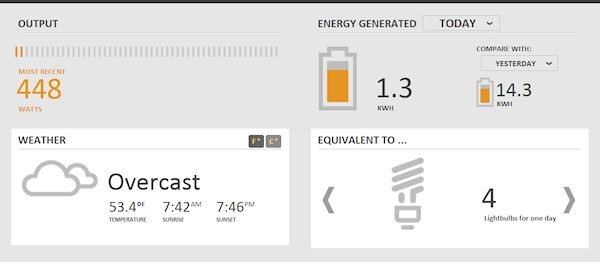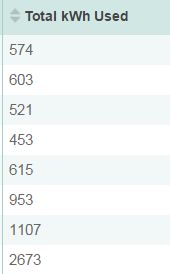Did you think you were going to get off that easy? Did you think you would never have to hear about solar panels from me again? Nope . . we LOVE our solar panels! This post will be boring as heck for anyone not interested in solar, but if you are interested, here’s our report as we near the end of our first year .
We are so pleased with Longhorn Solar (Austin, Dallas and San Antonio, Texas). We have a friend who has a friend who put in a system with a different company and they have had lots of problems with their system and are pretty much unhappy with it. I can’t imagine spending that much money and being unhappy with the investment. There are many good companies out there so if you decide to go with solar, do your homework. Vince researched the heck out of solar companies before deciding on Longhorn.
The only problem we’ve had is this . . there’s a little wireless gizmo that transmits everything about our solar system to some company that reports it all online so at any time, we can get on our computer or iPhone and see how much power each panel is producing and the totals, as well as the history of each panel and the total system.
Today was not a good day to show this because it’s raining and cloudy.
We’ve had almost 1/2″ rain already today. That’s a gully washer in these parts! 🙂 We can’t have both .. good solar production and rain and we’ll take rain any day.
Back to the solar reporting, the little wireless gizmo is a third party component that Longhorn buys and apparently they just don’t hold up. Most of the time, Longhorn noticed it wasn’t working before we did. It involves unplugging the broken one from the internet and plugging in the new one. Vince offered for Longhorn to leave them here and he would do it so they don’t have to send someone from Austin but they insisted . . that’s part of their warranty work. They finally gave up on the wireless gizmo and last week, a guy came and spliced into our internet line and hard wired another reading/reporting device and he said that one will work nicely for us. They always try the wireless device because it’s easier and holds up fine for some systems but because ours is all out in the shop without heat or air conditioning, it was just a little much for the wireless device.
So . . about our production. This screen shot shows how many kwh we’ve used (purchased from the electric company) since getting the solar panels installed.
I started to crop it out but if you notice the bottom number, 2673 kwh were used on the bill we got in August. The company that reads our meter had not been able to figure out how to report our usage so in August, they finally got it right so that number represents our usage for May, June and July. The September bill, 1107 kwh, was for 40 days instead of 30 and by the time the October till (653 kwh) came around, they had it all figured out.
It isn’t easy to figure out how much we’re saving because the numbers shown above represent only the kwh we purchased from the electric company. We have to read the solar panel meter to know how many kwh we produced and then subtract how many we sent back and that tells us how many we used.
This is from our electric bill that we received yesterday. We purchased 574 kwh and sent back 619 kwh and you’ll see that we sell them back for more than we pay for them . . sell them at .075 and buy them at .062. Our contract is up on May 1 and the new contract we’ll sign is for a plan that only charges .047 (I think that’s the number Vince told me) so long as we use less than 1,200 kwh, and we will, but if we go over, it goes back up to about .06 per kwh. They will continue to buy kwh back from us at .075.
We also pay about .10 per kwh for using the lines. We only pay that on the kwh we buy. We do not pay it on the power we generate nor on the power we send back. This is our line charge for the current bill.
Here’s how we calculate our savings:
Last month we purchased 574 kwh.
We used 524 kwh that we produced and sent the rest to the utility company (It was a cloudy, rainy, icy month).
That’s a total of 1098 kwh.
Based on what we pay (16.2 cents per kwh), our bill would have been $177.88. It was $51.04 so we saved $126.84. That’s one of the lowest monthly savings we’ve had. According to our calculations, over 10 months, we’ve saved about $1,680 on our electric bills. With two months remaining to round out a 12 month period, we’re projecting a savings of an additional $300, to make a total savings of $2,000 for one year, which is adds up to an 8 year payback for our solar system, which is exactly what we had calculated.
The panels themselves have a 25 year warranty and the inverters have a 10 year warranty. IF electric rates stay the same (and who expects that to happen?), after 7 more years, we will have recouped our investment, and any savings will be money in our pocket. Even once the solar panels have paid for themselves, there’s still the added value to the property by having them.
This was a great investment for us and we’re 100% happy with it.






Vickie VanDyken says
Wow that is great! We are seriously considering solar, especially for our water well! We’d like to keep that if the power is out 🙂 Our shop is good sized and I imagine in Wa with all the cloudy weather it might take us longer for payback, but we think it would be worth it to have a small bit of independence.
Hubby is usually gone so I have been checking systems in the area. It is a long and involved process. I remember your trials even after you thought you were done! Thanks for the update. It bolsters my resolve to get it done!!
Judy L. says
Solar for a well pump is easy. We’ve had that for 2 ÿears in the orchard. We don’t use batteries — when there’s sun, the water flows. No sun, no water, but it would be fairly easy to set up a dedicated solar array for one item since you know exactly how much power it requires.
Yes, less sun definitely adds to the payback period. There are online calculators that tell you how much sun hours you get and your payback time based on that number.
Katie Z. says
Fabulous! We’re tossing around solar still, so I’m really happy that your system is working out well.
Kate says
Hey Judy – I’ve been wondering what happens when you have solar panels on the roof, and your roof needs replacing…. also, does ice damage your solar panels?
You have really piqued my interest !!! You should be a salesman! Maybe you already are…
Judy L. says
I’m assuming they have to be dismantled for a roof repair or replacement. I definitely would not recommend placing them on a roof that you know will need to be replaced anytime soon. We have lifetime metal roofs here so that was not a consideration for us. As for as ice, I don’t think it will hurt them. If it causes a thick enough coat of ice (or snow) to be on them, they will stop producing power. Hail is another consideration. We have quite a bit of hail here. We have the solar panel at our gate, another one at the well in the orchard, and the ones on the shop roof, and we have never had any hail damage to them. On the other hand, two of our vehicles have received hail damage here.
Solar power companies familiar with the conditions in your area should be able to give you a good idea of how they will hold up under your weather conditions.
Susan says
Not for how wet it’s been here, but if I were in the southwest, I’d want it. Last year when you were researching this, I looked up the site you gave that could tell me if it would be efficient here. It was marginal, and it would probably not have been paying me much back this year, but I could still have saved some money, I’m sure. I think it’s interesting that they pay more than they charge you.
Joyce says
Love your savings. I’m glad you got to do the math, though…I got a little lost there. (Math has never been my strong point–I was a music major–I only had to be able to count to four.) 🙂
Bonnie in Va says
We’ve had a major solar array in our back yard for about 4 years. Ours was substantially more expensive than yours but we are seeing savings pretty regularly. The years that have been wet and gloomy we don’t produce as much energy. This winter has been especially snowy/sleety/rainy and very cold for several months. We are paying for more energy than usual. The summer months, despite how hot it is usually generate enough energy to pay all of our electricity bill and the house is totally electric. What you don’t mention is the CO2 that is saved by using solar. We’ve saved tons since the beginning. Nice to lessen our carbon footprint some. The one thing we do need to do is clean snow off them when we have snow. Generally we can brush it away or at least as much of the panels as we can reach with a broom. We too love solar. What we don’t have is a battery that allows us to store excess power instead of sending it to the power company. Oh well. That unit got even more expensive for us. Sigh.